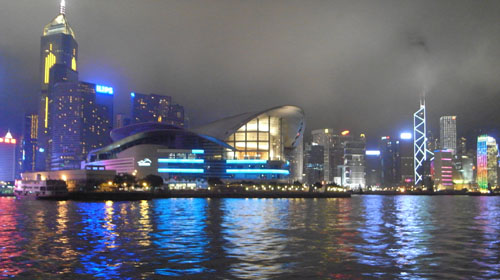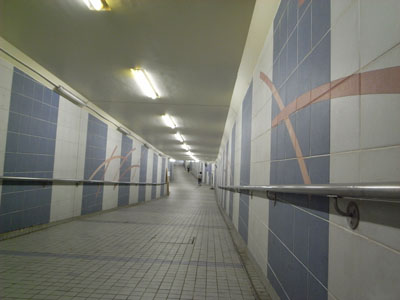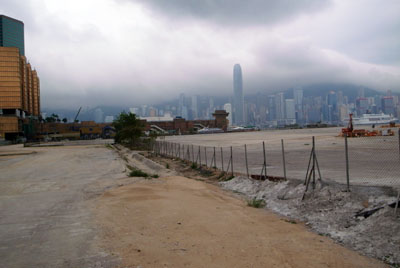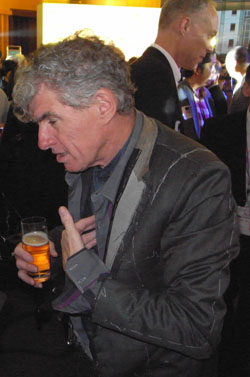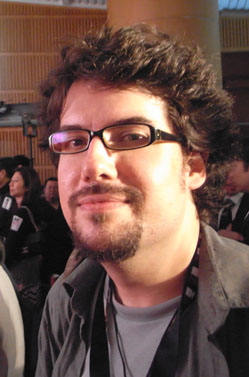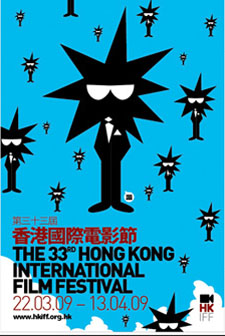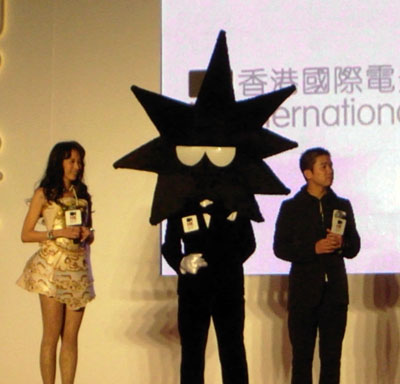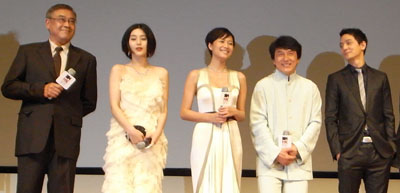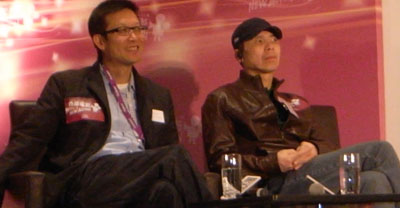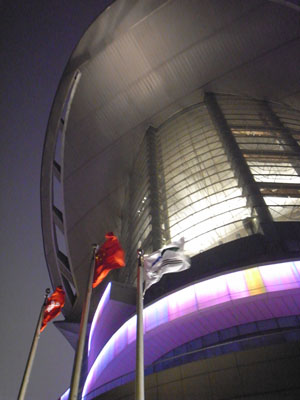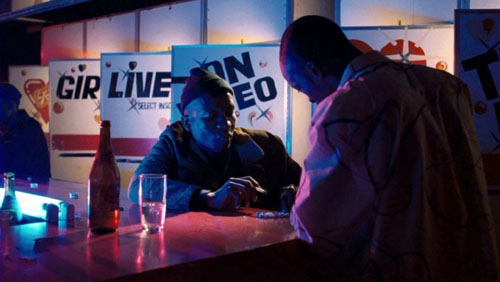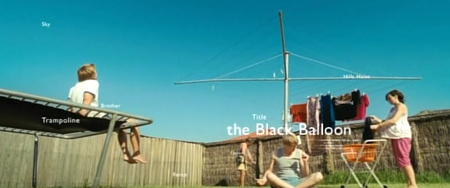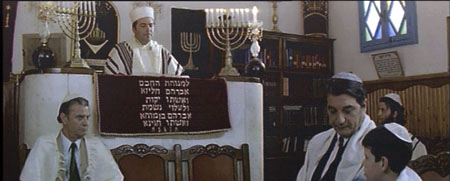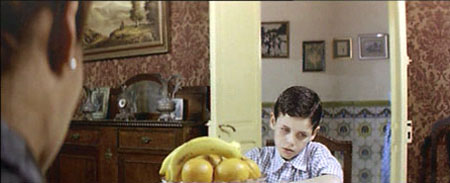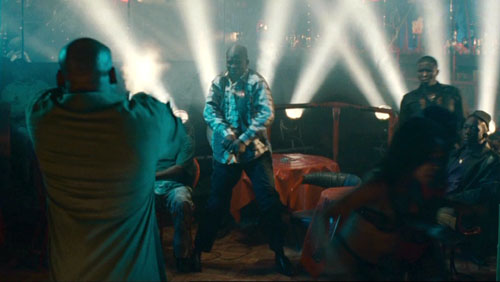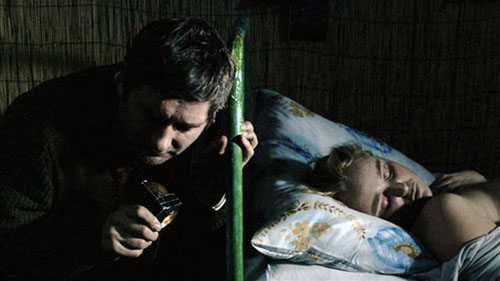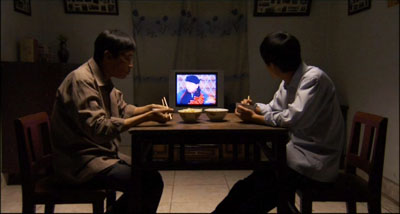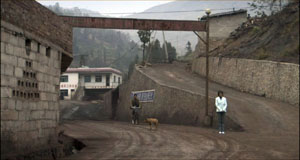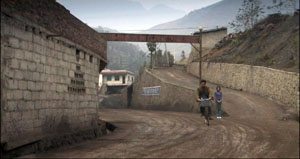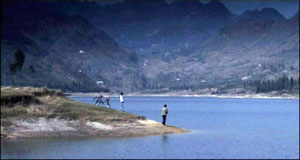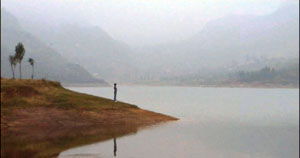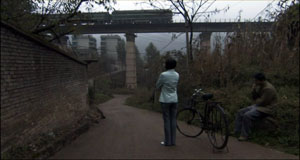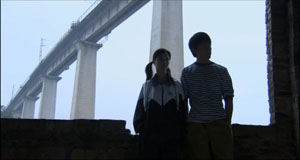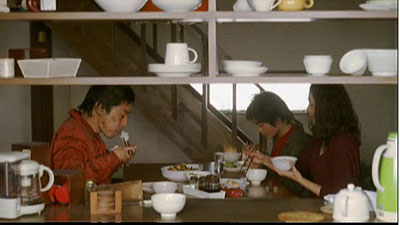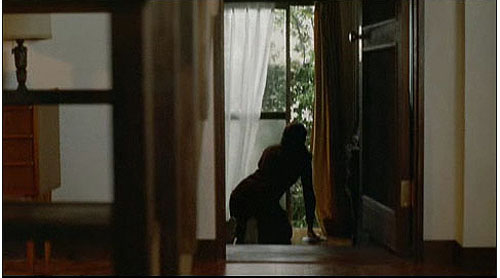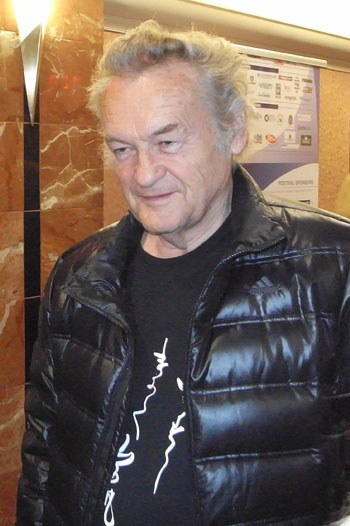Archive for the 'Festivals' Category
Jackhammers, parties, and markets
DB here:
No matter how often you see this Ur-touristic view, it’s still spellbinding. Yes, I’m back at the Fragrant Harbor for the annual festival, front-loaded with Filmart, the film market. My 2008 report starts here, and the 2007 one starts here. Plenty of entries for those years; I’m not sure I’ll be able to roll out so many this time, but we’ll see.
Start with the first impressions. Massive building projects and new traffic-flow strategies have made the tip of the Kowloon peninsula even more pedestrian-unfriendly than last year. Grim underground passages take you in loops away from your destination. No more direct routes anywhere, it seems, and construction projects I’ve watched for years continue to be unfinished. From the twenty-first story of my hotel I can hear a jackhammer at street level.
A striking case: My hotel is rather close to a multiplex in West Kowloon, located in an upscale mall called Elements. (More on Elements in a later communiqué.) But around this trendy spot stretches a vast vacant lot.
Again, there’s a lot of pedestrian control, including barriers to keep you from crossing the street. Still, it’s not hard to find places where enterprising passersby, perhaps armed with blades, have broken on through to the other side.
Moreover, the Star Ferry to Wanchai still offers a pleasantly sustained ride and the usual spectacular views, even in the rain and mist that have enveloped my first days here.
Wanchai is the location of Filmart, set up in the Convention Centre, the mammoth swooping building seen at the top and bottom of this entry. As usual, Filmart was stuffed with seminars, screenings, and dealmaking, as well as the Asian Film Awards.
The opening of Filmart included a party, where you could find Chris Doyle, accompanied by a beer, rubbing shoulders with Stefan Borsos, editor of the German magazine CineAsia.
The party got stranger. This year’s festival logo is a dude in black tie with a black starburst head and a hollow look around the eyes. I thought he was only a graphic design until Karen Mok brought him onstage.
He seems a saucy fellow, at least judging from his hand gesture here.
Filmart opened with a screening of Derek Yee‘s new film Shinjuku Incident. Before the show, Yee, on left, lined up with his cast. You can recognize at least one of the ensemble, grinning as usual.
In the following days, I saw several good movies: More on them in the next post in a day or so. I also attended some sessions devoted to technology and marketing. The effects company Digital Magic sponsored a demonstration of various digital formats, of which the Red system seemed to me the best. Digital Magic also gave out cute Viewmaster-like toys promoting their work.
 I learned things from this session and the one sponsored by Salon Films, but the main live event I hit was the Hong Kong Film New Action Forum, a day-long series of sessions about the future of Chinese film. The first item was a brief discussion moderated by director Gordon Chan (Beast Cop, Painted Skin; left). Two experts discussed the current status of CEPA, the Closer Economic Partnership Arrangement that allows Hong Kong productions to count as mainland ones for purposes of financing and distribution. Across the last few years, half or more of the top-grossing pictures, such as the Zhang Yimou costume epics and Peter Chan’s Warlords, have been CEPA-enabled coproductions. Other countries, such as Singapore, Japan, and Korea, are investing in such projects.
I learned things from this session and the one sponsored by Salon Films, but the main live event I hit was the Hong Kong Film New Action Forum, a day-long series of sessions about the future of Chinese film. The first item was a brief discussion moderated by director Gordon Chan (Beast Cop, Painted Skin; left). Two experts discussed the current status of CEPA, the Closer Economic Partnership Arrangement that allows Hong Kong productions to count as mainland ones for purposes of financing and distribution. Across the last few years, half or more of the top-grossing pictures, such as the Zhang Yimou costume epics and Peter Chan’s Warlords, have been CEPA-enabled coproductions. Other countries, such as Singapore, Japan, and Korea, are investing in such projects.
The other session I attended was more high-profile. Philip Chan, screenwriter and former cop, moderated a discussion among John Woo, Oliver Stone, Andrew Lau Wai-keung, and Feng Xiaogang. The Chinese directors talked about the market. Stone talked about creativity. This division of labor reminded me of what Bernard Shaw supposedly told a Hollywood producer: “The problem is that you are only interested in art, and I am only interested in money.”
 Woo took the floor with a long discussion of making Red Cliff. He made the usual point about wanting to wed Chinese stories to Hollywood production values. Some other items:
Woo took the floor with a long discussion of making Red Cliff. He made the usual point about wanting to wed Chinese stories to Hollywood production values. Some other items:
*He built the project to have marketing appeal, designed both for Asian and western consumption. For instance, strong women appeal to female viewers in all countries. He claimed that one reason that Red Cliff broke attendance records in Japan was the support of women audiences.
*Woo also wanted to bring audiences in Hong Kong and China back to local films, away from Hollywood imports. Viewers, he claims, are bored with Hollywood’s formulas and want something fresh and authentic. But local audiences are getting tired of Chinese blockbusters too, so in Red Cliff Woo introduced humor along with Hollywood-level production values.
*He suggested that before making Red Cliff he had considered retiring. Now he’s planning more projects.
Lau and Feng likewise took up practical considerations. Lau said that filmmakers must go where the market leads. He suggested there was a period when Hong Kong filmmakers went to Hollywood, but now that route is risky. At the moment, the market is the Mainland, not the West. He was not rueful about his own experience in Hollywood (with The Flock), but he treated it as a chance to learn “a different set of rules. Every place has its own rules.” He also spoke of the unexpected success of Infernal Affairs, a “back-to-the-wall” effort that seemed risky in the market decline of the 2000s. No one expected the film to be so successful; the actors cut their asking prices to be in it.
Feng Xiaogang, Mainland director of Cell Phone and A World without Thieves, lived up to his reputation for stirring things up. Announcing that Hong Kong people “consider the Mainland a four-letter word,” he rattled off an account of the current PRC market. Feng indicated that a $20 million film can presently break even in the domestic market. This prospect interested me, because such benefits are rare in the history of movies. As film students know, the US used its big domestic market as a base to launch vast overseas distribution.
Box-office income is growing fast, but there aren’t enough screens. He claimed that there were about 4000 in the country, an absurdly small number for such a populous country. (Probably this figure counts only modern screens, not old or temporary ones.) The key, Feng suggested, was capitalizing the building of still more screens, especially in the 350 “small” cities. The government will subsidize theatre construction to some extent.
If 1000 more screens are added, Feng speculated that in five years the annual box-office receipts could hit 30 billion RMB. That’s about $4.5 billion, somewhat less than half of the 2007 US box-office take—but twice as much as the income in Japan for the same year. China is developing into a prepossessing market.
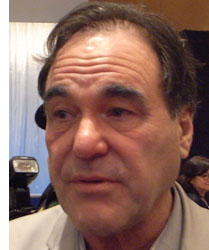 Finally, Oliver Stone confessed his love of Asian films, singling out their “iconic imagery” (Crouching Tiger, even Woo’s Face/Off) and lyricism (Ozu, Wong Kar-wai). His advice: Don’t withdraw from engagement with the West and “Make films that pop their eyeballs out.”
Finally, Oliver Stone confessed his love of Asian films, singling out their “iconic imagery” (Crouching Tiger, even Woo’s Face/Off) and lyricism (Ozu, Wong Kar-wai). His advice: Don’t withdraw from engagement with the West and “Make films that pop their eyeballs out.”
One theme I took away was the way in which regionalism continues to rule the Asian industries, a topic I raised in Planet Hong Kong and in late chapters of Film History: An Introduction. Who needs Western markets if the PRC market continues to swell and if other territories in the area hold up their end of financing, distribution, and the occasional regional hit? As far as mass-market cinema is concerned, we may be moving toward a bipolar world, with North America at one pole and Asia at the other. For an excellent, fact-filled analysis of the implications of this trend toward regionalism, see Darrell William Davis and Emilie Yueh-yu Yeh’s brand-new study, East Asian Screen Industries.
Soon, very soon, we go to the movies.
Screen Digest offers some slightly older statistics on the Mainland market here. For more recent information on Chinese exhibition in a worldwide context, see “Exhibition Breaks Revenue Record,” Screen Digest (September 2008), 274. The number of screens cited here is far greater, perhaps because it counts all the rural, unmodernized, or temporary venues. Karen Chu of the Hollywood Reporter sums up the New Action Forum event here.
Hong Kong Convention Centre.
Sitting under a palm tree made of film
Jerusalema.
Kristin here–
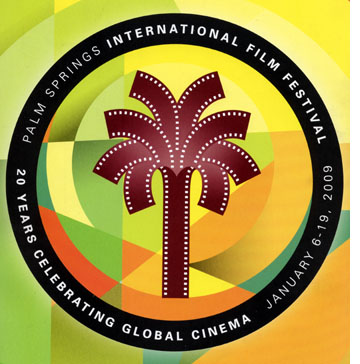 The Palm Springs International Film Festival has a logo calculated to appeal to those of us who travel from snowy northern climes to attend: a palm tree composed of strips of film. As each film began and a short prologue listed the sponsors, I studied that logo and felt grateful that I was missing the frigid weather that descended upon Madison during our absence. It’s a clever design, also managing to suggest movies springing forth in abundance, which was certainly true of the festival’s offerings.
The Palm Springs International Film Festival has a logo calculated to appeal to those of us who travel from snowy northern climes to attend: a palm tree composed of strips of film. As each film began and a short prologue listed the sponsors, I studied that logo and felt grateful that I was missing the frigid weather that descended upon Madison during our absence. It’s a clever design, also managing to suggest movies springing forth in abundance, which was certainly true of the festival’s offerings.
Two from the Antipodes
Most New Zealand films are set in their home country, taking advantage of its magnificent landscapes and local culture. Dean Spanley (Toa Fraser) strikes me as quite different. Based on a Lord Dunsany fantasy novella, My Talks with Dean Spanley (1936), it was mostly filmed in England and is a costume piece set in the Edwardian era. Five years ago co-productions were rare things in New Zealand, but this is a Kiwi-U.K. film with an impressive international cast. There are Englishman Jeremy Northam as the narrator and protagonist, New Zealander Sam Neill in the title role, Australian Bryan Brown (perhaps most widely known as Breaker Morant) in a supporting part, and Peter O’Toole. The latter is spoken of as a possible best supporting actor Oscar nominee, though I fear that the film is too low profile for that.
[Correction, January 26. Bryan Brown appears in Breaker Morant as Lt. Peter Handcock, not in the title role.]
Dean Spanley is a feather-light but well-told tale of Fisk, a middle-aged man who pays a tense visit to his  curmudgeon of a father (played by O’Toole) once a week. For something to do, Fisk takes the old man to a lecture on reincarnation, also attended incongruously by the local preacher, Dean Spanley. A friendship develops between Fisk and Spanley as it gradually comes out that Spanley seems to be the reincarnation of the father’s beloved childhood dog. The premise is made plausible by a gradual revelation of the premise, by Neill’s performance, and by some lyrical flashbacks. The whole thing is a surprising film to have come from Fraser, whose first feature, No. 2, was set in Auckland and concerned a family of Fijian descent. Yet it seems a sign of the New Zealand cinema’s health that he could take such an unexpected turn and tackle an English literary adaptation.
curmudgeon of a father (played by O’Toole) once a week. For something to do, Fisk takes the old man to a lecture on reincarnation, also attended incongruously by the local preacher, Dean Spanley. A friendship develops between Fisk and Spanley as it gradually comes out that Spanley seems to be the reincarnation of the father’s beloved childhood dog. The premise is made plausible by a gradual revelation of the premise, by Neill’s performance, and by some lyrical flashbacks. The whole thing is a surprising film to have come from Fraser, whose first feature, No. 2, was set in Auckland and concerned a family of Fijian descent. Yet it seems a sign of the New Zealand cinema’s health that he could take such an unexpected turn and tackle an English literary adaptation.
Australian movieThe Black Balloon (Elissa Down) is a contemporary story set in a Sydney suburb. It’s a social-problem film, dealing with a teenage boy, Thomas, torn between his love for his severely autistic brother (a truly remarkable performance by Luke Ford) and his frustration at the effect the brother’s antics have on his own ability to fit in at his new school. The film is apparently aimed primarily at a teen audience (it won the Crystal Bear for “Generation 14plus – Best Feature Film” at the Berlin Film Festival), but the almost exclusively adult audience at Palm Springs seemed entertained and touched by it. Australian stars who have made careers abroad often return to support their native industry by acting in local films, and Toni Collette is impressive as the mother. I found it a bit of a stretch that the one sympathetic, understanding fellow student Thomas finds happens to be a gorgeous girl who also seems to have no friends among their classmates. Apart from that, it’s an entertaining and informative film.
It does have one intriguing device in the pre-credits and credits scenes: several objects in each shot contain superimposed words identifying a number of the objects visible. The idea presumably is to suggest the fact that autistic people have excellent object recognition but difficulty understanding others’ emotions. I would have liked for the labeling to continue through the film, but I suspect most other viewers wouldn’t. Admittedly that would have distracted viewers from the narrative–unless we soon got used to it, which I suspect would have happened. At any rate, it’s a catchy way to introduce the story.
Another Exodus
Watching the Moroccan film Goodbye Mothers (Mohamed Ismail) was a disconcerting experience. At first it struck me as simply old-fashioned filmmaking, with multiple plotlines concerning three Jewish families living in Morocco at a time of increasing racial tensions. The stories are the stuff of melodrama, with a beautiful Jewish girl in love with a Moroccan man, a man debating whether to abandon his long-time friend and business partner to move his family to Israel, and the partner’s childless wife, who would be devastated by the departure of the family’s children, to whom she has been a second mother. In this age of short scenes, the film bases its action largely on extended shot/reverse-shot conversations, without much moving camera or many tight close-ups.
Eventually I realized that the film looks very much as if it had been made around 1960, which is the period of the story’s action.
The similarity can’t be coincidental. As with other Moroccan films I have seen, there is considerable emphasis on the music track, and here two or three scenes use the sweeping theme from Preminger’s Exodus. Indeed, the style is occasionally reminiscent of Preminger’s work of that era, as in shots that position characters precisely across the wide screen.
There’s also the sort of depth composition with a head prominent in the foreground that one associates with widescreen 1960s films by Nicholas Ray:
There’s more cutting than Preminger would typically use, but it’s an interesting pastiche that lends some subtle overtones to the film’s action. Despite a wide range of performance styles and a somewhat schematic set of plotlines, the film is an intriguing attempt to use a throwback style to convey the period when the peaceful co-existence of Jews and Muslims in Morocco was breaking down.
The quest film grows up
A few films do not necessarily a pattern make, but I’ve been struck by some echoes among the Middle Eastern films I’ve seen at this and other festivals. When the New Iranian Cinema came to international notice in the 1980s and 1990s, one narrative premise that several films shared led them to be labeled “child quest” movies. These tended to be simple searches or journeys: a boy trying to return his friend’s school notebook (Kiarostami’s Where Is My Friend’s Home?, 1987) or a girl trying to make her way through traffic to get home after school (Panahi’s The Mirror, 1997).
Gradually disasters, natural and manmade, caused the quests to become more serious. They often still involved children, but the just as often the seekers have been adults. Kiarostami’s And Life Goes On (1991) dealt with a film director’s journey into an earthquake-devastated area to find the child actor of Where Is My Friend’s Home?, who happened to live in the worst-hit area.
More recently, though, the disasters that create quests are wars in the region. My Marlon and Brando, the first feature of Turkish director Huseyin Karabey, deals with a actress in Istanbul. She has fallen in love 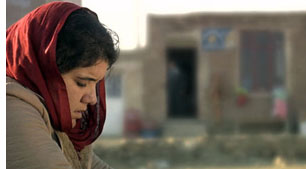 with an Iraqi Kurd, and when the U.S. launches its invasion of Iraq, the two are cut off from each other. Increasingly frustrated and desperate, the heroine sets out to join her lover in his home in northern Iraq, even though the convoluted set of border closings forces her to go by bus via Iran.
with an Iraqi Kurd, and when the U.S. launches its invasion of Iraq, the two are cut off from each other. Increasingly frustrated and desperate, the heroine sets out to join her lover in his home in northern Iraq, even though the convoluted set of border closings forces her to go by bus via Iran.
As she meets obstacle after obstacle and finds herself isolated in small villages where she cannot speak the local language, the film risks becoming monotonous. But audience attention is carried in part by a remarkable performance by Ayca Damgaci, who must carry every scene. At intervals we see videotaped messages sent to her by her lover. His effusive professions of love are juxtaposed with clips from the film where they had acted together, and these messages lead one to wonder just how sincere he is. Might he be leading her on through her grueling trek just to find disappointment?
My Marlon and Brando reminded me of Under the Bombs, which I wrote about from the Vancouver Film Festival. (It was also shown at Palm Springs.) There a distraught Lebanese woman travels by cab into the southern area bombed by Israel in 2006, seeking her son. Both films stress the difficulties of ordinary people’s making their way through combat areas or having to detour around them.
Another variant comes in Ramchandi Pakistani (2008), made by Mehreen Jabbar, one of several female  directors who have emerged in the Middle East. The mischievous Pakistani child Ramchandi wanders away from his village in Pakistan. He accidentally crosses the border into India—a border marks only by rows of painted white stones, giving the child no indication of the danger he faces. His father follows in an attempt to find him, and both are thrown into an Indian prison for years, their unregistered status making release highly unlikely. The film then alternates between the plight of the pair and their fellow prisoners and the frantic efforts of Ramchandi’s mother to find out what has happened to them and to eke out a living while hoping for their return.
directors who have emerged in the Middle East. The mischievous Pakistani child Ramchandi wanders away from his village in Pakistan. He accidentally crosses the border into India—a border marks only by rows of painted white stones, giving the child no indication of the danger he faces. His father follows in an attempt to find him, and both are thrown into an Indian prison for years, their unregistered status making release highly unlikely. The film then alternates between the plight of the pair and their fellow prisoners and the frantic efforts of Ramchandi’s mother to find out what has happened to them and to eke out a living while hoping for their return.
The three films deal with different conflicts: U.S.-Iraqi, Israeli-Lebanese, and Indian-Pakistani. All three stress the separations of families and lovers by hostilities and the barriers they arbitrarily create for ordinary people.
A small drama far away
In contrast, the Kazak film Tulpan (Sergei Dvortsevoy) presents flat, limitless, arid plains of southern Kazakstan, where borders and conflicts seem so far away as to be irrelevant. Asa, a veteran of the Russian navy, does not go on a quest but has a pair of local goals. He seeks to marry the elusive Tulpan and to establish his own flock of sheep. As he struggles to achieve 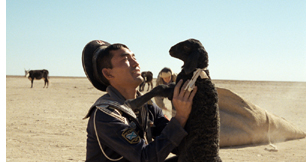 these goals, Asa remains an assistant to his brother-in-law Ondas, a tough, seasoned herdsman who keeps finding his ewes’ newborn lambs mysteriously dead.
these goals, Asa remains an assistant to his brother-in-law Ondas, a tough, seasoned herdsman who keeps finding his ewes’ newborn lambs mysteriously dead.
The film is director Dvortsevoy’s first fiction feature after a career as a documentarist, and he skillfully details the lives of Ondas and his family. There are two remarkable, squirm-inducing scenes of the births of lambs, handled in long takes that seem to make trickery impossible. Despite the hardships and disappointments, there are touches of humor, as when the local vet stops by to investigate the dead-lamb problem, accompanied by a bandaged baby camel in the side-car of his motorcycle and followed by its persistent, annoyed mother. A charming film and a crowd-pleaser.
See the film, avoid the city
During the Q&A after the screening of Jerusalema that I attended, queries from the audience tended to center around how accurate its depictions of rampant crime and violence are. Director Ralph Ziman assured us that they are quite accurate, and indeed the film is loosely based on a combination of true cases. Johannesburg, he claimed, is the world’s most violent city. Whether that’s strictly true, I don’t know, but Ziman’s film is a polished, gripping depiction of one brilliant young student’s rise and fall (and rise?) as a criminal. The script, with its complex flashback structure, is tight and fast-paced. The cinematography is consistently imaginative and beautiful. (See images at top and bottom.) I can best describe it as Michael Mann shooting a gritty Hong Kong action film, but setting it among Johannesburg gangs. The Mann influence is palpable. At one point the characters watch a scene from Heat to learn how to ambush an armored car, and Mann is among those thanked in the credits.
Jerusalema was South Africa’s submission for a nomination as the Best Foreign Film for the Oscars. Not surprisingly, it didn’t make the shortlist, being an action pic rather than the art-house fare that the Academy members favor. Its language is also a disconcerting melange of the tongues and dialects spoken in South Africa, including English. At times characters switch among languages in mid-sentence. According to Ziman, the script was written in English, and then the cast helped work out how their individual characters would speak the lines.
The basic story is familiar, with a teenager, Lucky, from Soweto accepted into a university but unable to pay his fees and intending to turn to crime temporarily to raise the requisite money. Naturally he tries to quit, only to be lured back. But Lucky uses his intelligence to work out a novel way to twist the law to his advantage, commandeering crime-ridden apartment blocks that have been allowed to slip below legal standards and buying them at bargain prices. It’s the dynamic style, though, that makes this so entertaining. It was one of my favorite films of the festival. Ziman announced that it had recently been sold for American distribution, but he would not reveal the name of the company before an official announcement. I’m not sure whether it would fit better into multiplexes or art theaters. Like so many recent films it seems to fall in between. (The Curious Case of Benjamin Button and Slumdog Millionaire are only the most recent examples that come to mind.) Its subtitles make it unlikely to find a really wide audience, but its violence might be off-putting to the art-house crowd. Wherever it ends up, it’s worth looking out for.
A final thought
During the festival, I was struck a number of times by how well-made films were that came from countries where production has previously been minimal. From South Africa, Kazakstan, Morocco, and Pakistan we see films that give the impression of having been made within a well-established industry. They adeptly use conventions familiar from festival-aimed art films or from classical Hollywood-style cinema. Clearly filmmakers in such countries have been seeing a lot of movies, even if they haven’t been making very many yet. The cliché about the cinema as an international language, almost as old as the medium itself, apparently remains as true as ever.
Note: Variety‘s wrap-up of the Palm Springs International Film Festival, including the prizes awarded, can be found here.
Three from Palm Springs
Four Nights with Anna.
DB here:
Three high points from the Palm Springs International Film Festival. Soon Kristin will offer some entries.
Four Nights with Anna is a GOFAM—a Good Old-Fashioned Art Movie. Set in a muddy Polish town, it follows a loner as he stalks a zaftig nurse. Leon watches her from around corners, studies her through her apartment window, and eventually sneaks sleeping powder into her sugar jar. This puts her out soundly enough to allow him to break into her apartment and watch her at close quarters.
My synopsis, like most retellings of this spare movie, not only spoils the experience but fundamentally changes it. Instead of laying out the premises explicitly, the film’s narration supplies them in tantalizing, equivocal doses. Skolimowski follows the great tradition of distributed exposition, so that we get context only after seeing something that can cut many ways. Early we see Leon buying an axe; soon he fishes a severed hand out of a sack and tosses it into a furnace. Is he a serial killer? No. After a while we learn that he’s the disposal officer for the hospital crematorium. Retrospectively fitting together these data provides a classic art-film pleasure, the equivalent of the curiosity-arousing clue sequences in a mainstream mystery.
The same goes for the ambiguous inserts that suggest a police interrogation. Only halfway through the film do these snippets become lengthy and explicit enough for us to place them in the story’s time sequence. Just as the Nouveau Roman of Robbe-Grillet owed a great deal to the classic detective story, the European art cinema tradition has drawn heavily on the investigation plot, from Les mauvais rencontres (1955) to The Spider’s Stratagem (1970). The premises of the thriller surface as well. The central conceit of Four Nights and of Kim Ki-duk’s 3-Iron, of a stranger who quietly and obsessively prowls around homes, was also explored in Patricia Highsmith’s 1962 novel Cry of the Owl, but not with Skolimowski’s playful indeterminacy about who and what and why.
The trick, then, is in the telling. By accreting details that cohere gradually, Skolimowski’s film not only engages curiosity and suspense, but also allows room for wayward, if dark humor. Leon’s quaking abasement leads to embarrassment, pratfalls, and comically strenuous efforts to melt into his surroundings. Objects take on a precise life, as Leon crushes his grandmother’s sleeping pills to powder and uses plastic silverware to fish a fallen ring from cracks in the floor. We never see Anna apart from Leon; she’s either in the same locale or glimpsed in precisely composed shots of her at her window. The exact, constrained handling of optical point-of-view owes a lot to Rear Window, but Jimmy Stewart never went so far as to install a new window to enhance his peeping.
In its diffuse exposition, its teasing inserts, and its gradually unfolding implications, a GOFAM also asks us to appreciate unresolved uncertainties. During the Q & A, Skolimowski remarked that he liked “to play with a little ambiguity . . . to leave it for the audience to interpret.” The locale? Indefinite, he says. The time period? Deliberately left vague. The mysterious final shot? “A third ambiguity.” For the man who made the kinetic Identification Marks: None (1964), Walkover (1965), Barrier (1966), and Le Départ (1967), film is something of a sporting proposition. It’s good to see him back in the game.
By contrast, The Shaft by Zhang Chi is a NFAAM, a Newfangled Asian Art Movie. That means minimalism. Single-shot scenes are captured by a distant, stable camera. Characters mutely go about their business, or just stand there. Pivotal plot moments take place outside the frame or between two static scenes. Any dramatic climaxes and grand passions are muffled or simply sufffocated.
The proximate sources of this Asian minimalism are probably the late 1980s films of Hou Hsiao-hsien. A European predecessor of the style, I think, is Fassbinder’s Katzelmacher (1969), but its most famous early instance would be Akerman’s Jeanne Dielman (1975).
Such a quiet style poses a problem: How to show plot changes and character development without lengthy dialogue? A common solution is to repeat setups in ways that diagram changes in character relationships. Have a young man pedal his bike up to his girlfriend and offer her a ride. Later as their relationship cools, show him in a similar framing riding callously past her.
Or show the couple wordlessly visiting a lake, but after they break up, show the girl standing there alone.
Tableaus can be used to parallel couples. Each pair meet near the village railroad trestle, but the compositions distinguish the couples.
Likewise, the shots showing the central family eating in front of the TV can be recalled through variation. The number of people at the table and their identities can change over the course of time.
The Shaft puts such conventions to solid use. In a rural Chinese town, young people face the choice of going to work in the mine or moving to Beijing. The film is built out of three stories, centering on a daughter, then her brother, and finally their father. At the end, the eventual revelation of what happened to the family’s mother throws the preceding love stories into sharper relief.
Once the innovators have mastered a style through dint of effort, others can glide down the learning curve and pick it up quickly. But then they should try to add something new. Today the rudiments of the minimalist style are comparatively easy to acquire. To go beyond those, you need something else—a more elaborate play with pictorial variations, or more ingenious staging (the Hou solution), or a gift for adjusting to the contours of landscape (the Jia Zhang-ke alternative). The Shaft is well-carpentered. It is measured and poignant (especially in its final story), and it concludes with a stunning trio of shots. Its very modesty, though, suggests the conventions of NFAAM need some renewal, even some shaking up.
Shaking things up is what Kurosawa Kiyoshi’s Tokyo Sonata is all about. A salaryman is downsized, but he can’t bear to tell his family. He pretends to go off to work while he actually tries to find a new job, any job. In the meantime, his sons display more ambition and courage in their limited worlds, than he does, while the mother tries to defuse the emerging tensions.
For an hour or so, this story is engrossing on naturalistic terms, alternating comedy and pathos. It might continue in a vein of gentle realism characteristic of that perennial Japanese genre, the shomin-geki, ending with everyone’s stoic reconciliation to the vagaries of life. But the director of Cure and Charisma will go along with this formula only up to a point. Why not break the form? You can argue that the simple purity of The Shaft plays too cautiously; once you’ve figured out how things will probably unfold, who cares to see the rest? A smooth cup is lovely, but a cracked one possesses its own enigmatic appeal.
So Kurosawa careens his homely tale into grotesque territory. The tone and plot logic that he’s cultivated so carefully are fractured by some violent emotions, implausible coincidences, and unexpected twists. Granted, his technique remains unruffled.Kurosawa follows Japanese traditions of enclosing faces in apertures and arranging people in gridwork patterns that still leave room for natural movement. The beginning of the story’s wild detour is discreetly signaled by a variant of the film’s first shot. But the composure of the handling makes the challenge to our expectations all the more disruptive.
I shouldn’t say much more, except to note that I meant the word fracture to suggest that the film mends its bones eventually. The final moments are taken up with a delicate performance of Debussy’s Clair de lune. Neither GOFAM nor NFAAM, risk-taking and in the end quite moving, Tokyo Sonata attests to the unpredictable innovativeness of Japanese filmmaking.
I may add other thoughts to Kristin’s upcoming dispatch, but for now I just note that Palm Springs is the only festival I know that uses Béla Tarr soundtrack cuts for pre-show music.
Tokyo Sonata.
Palmy days
DB here:
Kristin and I were invited to the Palm Springs International Film Festival for its twentieth-anniversary outing. We didn’t need much persuasion. Single-digit temperatures in Madison provided some motivation, but the first-rate program was the decisive factor. We’re grateful to our old friend (and former student) Alissa Simon, one of the PSIFF’s programmers, for helping arrange our visit, and to Emily Davis and Steve Wilson for being maximally welcoming.
We’ve already seen about a dozen films, and once we get some time in the next few days we’ll be writing up our responses to such extraordinary movies as Tokyo Sonata (Kurosawa Kiyoshi), The Shaft (Zhang Chi), Tulpan (Sergey Dvortsevoy), Four Nights with Anna (Jerzy Skolimowski), and several more. For now, let this snapshot of the lively Skolimowski stand in for the dispatch we will be posting later this week. His return, after a hiatus of fifteen years, is most welcome.












